Hi Chuck,
I am a volunteer member of the Friends of the Spanish River in Northern Ontario, Canada near where the Alligator boats were conceived of, designed, built and used extensively throughout Northern Ontario and beyond.
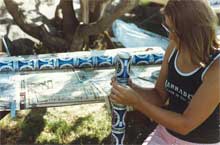 |
Suzanne is nesting, then duct taping rows of empty beer cans to build into Miss Canabeer. 90% of the floatation had to come from a used, empty beer can not altered in any way; Aussie rules.
(click photos for larger views) |
| Here you see the two hulls. One finished and one under construction. The rules state that you cannot surround the cans with fiberglass however, you can stick them together by applying sheets of fiberglass between the rows. Paul Hogan is helping us because this is an Aussie idea resulting in the Annual Darwin Beer Can Regatta in Australia. |
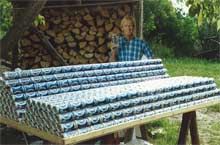 |
I am proud to state that I built 'Miss Canabeer', the first beer can boat in the Northern hemisphere. The only problem with a beer can boat is that you have to find volunteers to help build these boats who like to drink beer. 'Miss Canabeer' had 1500 'empty' Foster's Lager beer cans as her hull. The Aussie rules for any boat in their regatta were; used, empty beer cans not changed in shape and comprising 90% of the floatation of the hull.
 |
Jenn is putting the finishing touches on Miss Canabeer. You can see that the beer cans at the bow are not altered in any way; another Aussie rule.
|
| Suzanne, Jenn, Paul (and Paul) are promoting our Belleville Beer Can Regatta while acknowledging the Aussie connection. We gave away a trip for two to Australia worth $10,000.00 to attend the Darwin event in Australia the following year. |
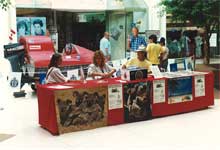 |
The Darwin, Austraila Beer Can Regatta is about to run their 34th Regatta sponsored by the local Lions Club. It's their concept and we used their Rules & Regulations for our regatta.
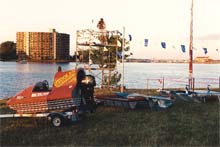 |
Miss Canabeer, The Spirit of Darwin and Cat Blue ready for the races to begin in Belleville, Ontario on Lake Ontario. |
| Pilot Suzanne just 'blasting off' in Miss Canabeer. |
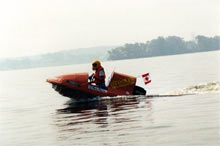 |
I am proud to state that the Australian Government commissioned me to build 'The Spirit of Darwin' which also had 1500 empty Foster's Lager beer cans as her hull. Unlike 'Miss Canabeer' which sported a brand new Merc 25 outboard, the 'Spirit of Darwin' was a trimaran that one could paddle or sail. I borrowed a Sunfish sail rig to power her.
 |
Even the business community got involved. Here is 'Kwik Kopy's' entry. |
| My pride and joy, 'The Spirit of Darwin' that I built by commission from the Australian Government at a cost of $500.00. This 'Rocket Sled' could be paddled and sailed. Of course, the Aussies had to 'crew' her just to make it legal. |
 |
All this happened as part of the Belleville Waterfront Festival in Ontario (a long time ago) complete with Tall Ships. I remember distinctly one evening during our Belleville Beer Can Regatta, we sailed by a Tall Ship with the mainly student crew relaxing by the rail. They all looked on with incredulity as we flew by them on a beam reach with all 'sail' up. That was certainly one for the books.
 |
Oh, and did I say that it got a little out of hand at times? We built the beer can boat in the foreground in twenty four hours on site just before the Regatta. |
By the way, the Aussies hold the Beer Can Boat World speed record of 58 M.P.H. Imagine a sleek, solid 'looking' J-boat built out of a pile of beer cans being pushed by a 160 H.P. Johnson Outboard and you have the picture.
Our winners, from right to left:
Paddle division: Cat Blue, (note the Aussie Stubbie beer bottle trophy)
Power division: The Beeracuda
Sail division: The Spirit of Darwin
Oh, and me proud as punch of my winners.
|
 |
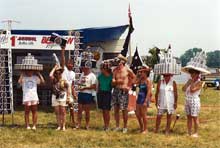 |
To put our regatta over the top, we also held a Beer Can Hat competition. The lady at the left won first prize. |
The Aussies used to run the Darwin Beercan Regatta yearly. That is where I got the idea and produced the Belleville Beer Can Regatta. Lot's and lot's of fun!
Here is an outline of the event:
BOAT EVENTS
- Class 1
World Cup Open Class power event
- Class 2
Maximum 25 hp. Class power event
- Class 3
Windjammer Race. Sail event. No
crew limit, Fire pumps, water bombs
may be used. Strictly sail unless
paddles authorized by committee if
calm.
- Class 4
- Team event. Maximum of six crew. Non-powered event
- Class 5
1 crew. Row or Paddle. Non-power
- Class 6
Celebrity Challenge Race. Nonpower.
Maximum of six crew. lnvitation
event.
- Grande Finale Event
Grand Finale sail past. Non-power
only. Waler bombs, fire pumps O,K.
All craft eligible provided they are
non-power.
- Special Event
Best beer can hat competition
CONSTRUCTION
- 1. The primary problem is to seal the cans. Even if they are not sealed but
are secured open end down, the hull will still work. Many commercial tapes
and adhesives are suitable to either cover the hole or join cans in pairs or
more with the open ends covered. Efficiency of the tapes or adhesives
should be tested in water.
- 2. An external frame or bracing is usable as is any version or wire
including tie wiring. Those methods are considered the cheapest and most
reliable lo use-even as just a security means of preventing the bare cans
from breaking away. The basic frame above water may be of any material.
- 3. 90% of the flotation must be from the used, empty cans themselves.
Four cans per kilo (2.2\b.) weight of the boat will provide adequate flotation.
External framework or can sealing material do not usually directly aid the
flolation but must leave 1/3 of each can bare.
- 4. Cans may be laid in three ways (or combination of each): upright, fore
and aft, and laterally. Upright willexpose only the can ends, is the strongest
on the outer hull but gives the second greatest drag. Fore-aft will give the
lowest drag but is the hardest to retain in the hull. Laterally is the easiest to
construct but is the most susceptible to can damage and gives the greatest
drag.
- 5. Motorized craft have the most problems. Vibrations, thrust and water
pounding become the most significant problems. A metal or metal-braced
wood frame is recommended for any motor mount.
- 6. Outer hulls of high-speed boats require the greatest attention to quality
of seal and can adhesion for the hull. The result of the force f rom 30 knots or
more on the hull can have crushing resultsl Great ingenuity is required in the
bow area. As cans cannot be flatlened and no plates are allowed externally. The higher powered classes should be approached with a certain amount of
professional method in experimenting and trial of designs, because full
disintegration can be a little disturbing.
- 7. To build your beer and/or pop can boat, you can use any standard (355
ml) or tall boy (473 ml) beer cans or any standard (280 ml) pop cans, and in
any combination.
- 8. Sailing craft can borrow sails and rigging from conventional sailboats.
Catamarans are faster and easy to build.
- 9. The detailed plans and suggestions below are simply guides to help
you build a safe, fun can boat.
BUILDING METHODS
 |
Tape cans in pairs - open ends together. Make sure tape is waterproof |
 |
Many boats are best built with cans taped in strings 1-2 meters long. Lay cans in a length of angle iron when taping to obtain straight strings. |
 |
Simple system (not suitable for power). Make a light wooden frame cover with chicken wire and fill with taped pairs or strings of cans. Additional strings may then be wired on outside for appearance. |

|
Strong design (suitable for power craft. Remember, the rules require outside layer of cans to be visible).
Place neat layer of cans on fibreglass while resin is wet.
layers of fibreglass between layers of cans.
Glue strings of taped cans to plywood with fibreglass resin.
Plywood base (becomes deck) |
 |
Sailing Craft -
Complete rigs borrowed' from
suitable craft are the eas¡est way.
Catamarans are generally faster
for size and easier built.
Points to walch:
Make everything about the same
size as the parent boat, except
hulls will probably be larger
cross section.
Mount the mast the same
distance from bow as the parent
boat.
Make sure cans are suitably
reinforced where mast mount,
horse and shrouds are attached. |

Two layers of cans all over with fibreglass between. Seats crosswise and footholds from layers of cans for extra strength. Use taped, sealed strings of cans. |
Rowing Skiff
Two building methods:
1 - Mould inside or outside existing hull or
2 - Make wood or steel frames; add wood or steel stringers; cover with chicken wire; tie one layer of cans on outside and one layer inside. |
Catamaran
(sail, row, low power outboard)
Build upsidedown
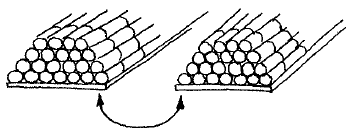 |
- stick cans to wood
deck w¡th fibreglass
- wire cans to wood
base
- make wood frame.
cover with chicken
wire, fill w¡th sealed
cans
(May be converted to 6-man
rowing team.) (Note: Boat should be 10 feet
long or longer.) |

|
Speedboat
(flat bottom-very fast)
(size 4' x 8')

Build upside-down on plywood deck. Use fibreglass matting and resin between layers
Paint all over with clear resin to prevent rusting.

|
Viking Canoe
(rowing - sailing)

18' (6m) can be any size
Add 6" (150mm) to width for each 2' (600mm) extra length.

Lay 3 layers of 1-2m strings of taped cans on base. Cover with extra layer of chicken wire. Tie through to outside layer every 500mm or so. Tie side and end cans on. |
10 CANMANDMENTS:
- Thou shalt enter the event in the right spirit - to have a great time
- Thou shalt build thy craft of cans - which must be drink cans, open, emptied adn in more or less their original state. Any attempts to enter a submarine (i.e. a craft made of full cans) will result in confiscation adn disposal by the committee.
- Thy craft shall float by cans alone - they have to provide at least 90% of your flotation. Anything can be used to stick them together, so long as it doesn't break this rule.
- Thou shalt not drown - any hull design is OK - so long as it's safe. Everyone on board must wear a proper flotation jacket. To avoid a repeat of the poseidon adventure, two cans of not more than 30 imp. fl. oz. (850 ml) must be used to every pound (454 grams) weight of craft and crew.
- Thou shall not take the name of thy craft in vain - any craft bearing signs or lettering that may be offensive will be barred.
- Thou shalt not drift from the straight and narrow and end up in Kingston - if anything goes wrong, we want to get you to shore safely and without disrupting the others. Make sure you have a tow rope that's no longer than the craft itself.
- Thou shalt not protest too much - no protests regarding eligibility will be considered once a race has started
- Thou shall honor thy committee - swearing, threats, stamping of feet and floods of tears wiill have no effect on decisions regarding eligibility and protests.
- Thou shall expose thy cans - one third of each can below the waterline must be uncovered and visible.
- Thou shalt go back and read the first canmandment again.
The idea of the regatta is that we built these boats for a Good time not a Long time.
OK so why didn't my regatta keep going you may ask? I had sponsorship money from the Canadian brewery that brews Foster's Lager Australian beer under license. The Ontario Liquour Control Board would not let the brewery participate after the first year. They said It would encourage young people to consume alchoholic beverages. No funding, no regatta.
You might have a better chance of creating a successfull Beer Can Regatta in the U.S.A. where the liquour laws are not so draconian.
Bill McKenna
|

